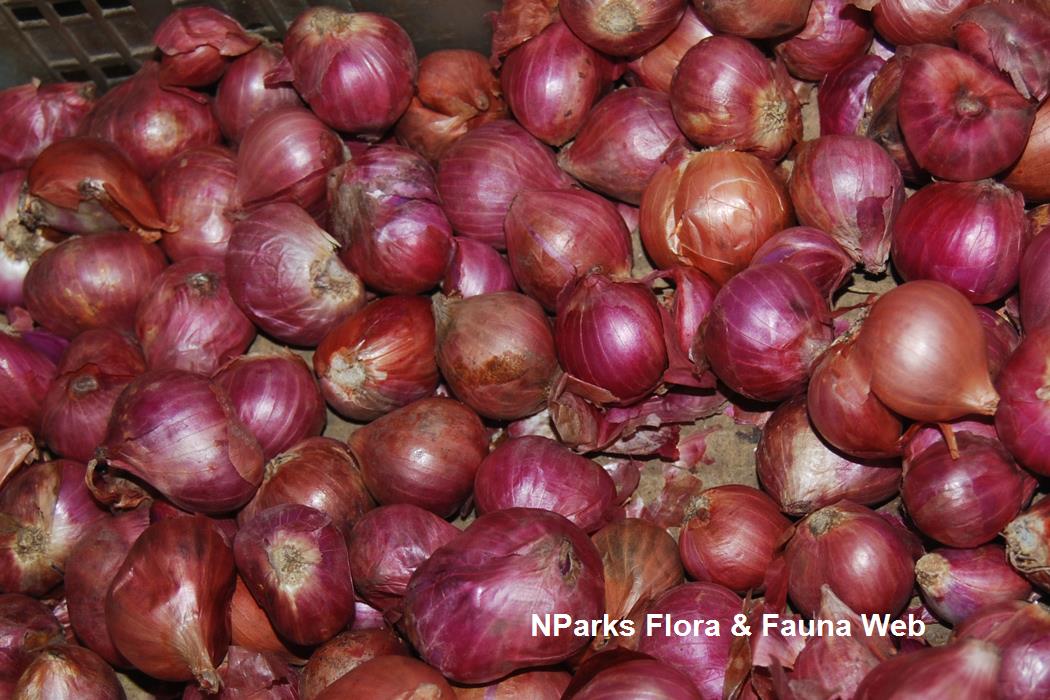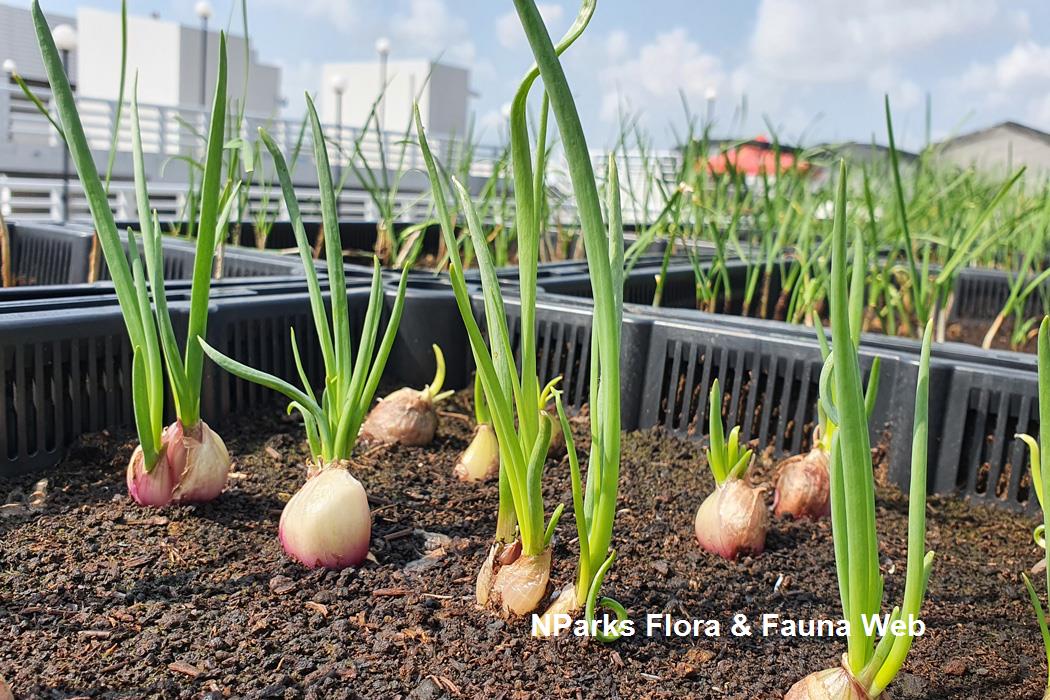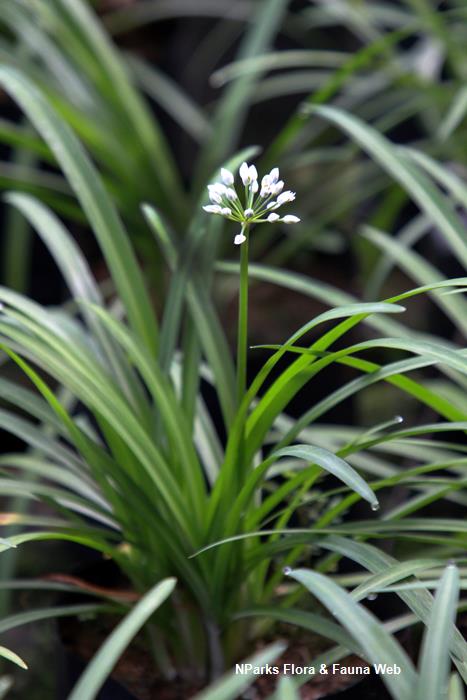
Back
Allium ascalonicum L.
| Family Name: | Amaryllidaceae |
| Synonyms: | Allium cepa var. aggregatum, Allium cepa var. ascalonicum |
| Common Name: | Shallot, 火葱, 分葱 |
Name
Classifications and Characteristics
| Plant Division | Angiosperms (Flowering Seed Plants) (Monocotyledon) |
|---|---|
| Plant Growth Form | Herbaceous Plant |
| Lifespan (in Singapore) | Biennial, Annual |
| Mode of Nutrition | Autotrophic |
| Maximum Height | 50 cm |
Biogeography
| Native Distribution | South-western Asia |
|---|---|
| Native Habitat | Terrestrial |
| Preferred Climate Zone | Tropical, Sub-Tropical / Monsoonal |
| Local Conservation Status | Non-native (Horticultural / Cultivated Only) |
Description and Ethnobotany
| Roots | Adventitious roots, 1-2mm in diameter, 10-25cm long, arising from true stem. |
|---|---|
| Foliage | 3-8 leaves, alternate arrangement, distichous, glaucous, produced in succession from the broadening stem apex, each arising as a ring which elongated to form the tubular leaf-sheath; leaf-blade cylindrical, light to dark green in color, hollow, erect or slanting. Bulbs formed by the thickening of leaf-bases a short distance above the true stem; as result of the rapid formation of lateral bulbs or shoots, clusters of 3-18 bulbs of the first and second order are formed; protective bulbcoat-leaves purplish, brownish or white; mature bulbs oblongoid, globular or oblate, up to 5cm in diameter, very variable in shape, size and color and weight. |
| Stems | True stem very short, flattened, form of a disk; pseudostem formed by the sheathing bases of successive leaves. |
| Flowers | Inflorescence a spherical umbel, 2-8cm in diameter, protected by a membranous spathe which splits into 2-4 persistent papery bracts; umbel with more than 50 individual hermaphrodite flowers; pedicel slender; flowers sub-campanulate to urceolate; tepals 6 in 2 whorls, ovate to oblong, 3-5mm long, greenish-white; stamens6; ovary superior; 3-locular, style simple, shorter than stamens at anthesis. |
| Fruit | A globular capsule, 4-6mm in diameter, splitting loculicidally, containing up to 6 seeds. Seed about 6mm x 4mm, black, wrinkled. |
| Ethnobotanical Uses | Edible Plant Parts : Edible Leaves, Edible Flowers, Edible Stems, Edible Roots, Edible Storage Organs Food (Fruit or Vegetable): Young inflorescence are eaten as vegetable. (Herb or Spice): Shallot(bulb) is used as food, spice and seasoning. It often used raw, sliced, mixed with soy sause and eaten with roasted meat. Shallot can be mixed with other ingredients and after grinding used as spice for meat and fish. Medicinal: Shallot is traditionally used to reduce fever and to cure wounds. In the latter case the bulb is sliced, mixed with coconut oil and salt, boiled and placed as poultice on the wound. Shallot is also used to lower blood sugar levels and inhibit platelet aggregation by eating it raw or cooked, as an extract or powder. |
Landscaping Features
| Landscape Uses | Small Gardens, Container Planting |
|---|---|
| Thematic Landscaping | Economic Garden |
Plant Care and Propagation
| Light Preference | Full Sun |
|---|---|
| Water Preference | Lots of Water, Moderate Water |
| Rootzone Tolerance | Moist Soils, Well-Drained Soils |
| Propagation Method | Seed, Storage Organ (Bulb), Division |
Foliar
| Mature Foliage Colour(s) | Green |
|---|---|
| Mature Foliage Texture(s) | Smooth |
| Foliar Type | Simple / Unifoliate |
| Foliar Arrangement Along Stem | Alternate |
Non - Foliar and Storage
| Stem Type & Modification | Herbaceous, Pseudostem |
|---|
Floral (Angiosperm)
| Flower Colour(s) | White |
|---|---|
| Flower Grouping | Cluster / Inflorescence |
| Flower Location | Terminal |
| Inflorescence Type | Compound Umbel |
Image Repository
Others
| Master ID | 31530 |
|---|---|
| Species ID | 5929 |
| Flora Disclaimer | The information in this website has been compiled from reliable sources, such as reference works on medicinal plants. It is not a substitute for medical advice or treatment and NParks does not purport to provide any medical advice. Readers should always consult his/her physician before using or consuming a plant for medicinal purposes. |





